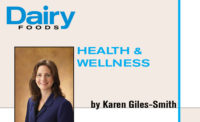
Public
tours of dairy plants may be a thing of the past, with the exception being at
plants that have segregated visitor centers.
Tillamook Cheese completed and commissioned the first phase of its Boardman, Ore. facility in the summer of 2001, shortly before the September 11 attacks. The security issues addressed in the design of the first phase were no less important, but somewhat different from those in play when the plant was expanded in 2005.
“As the manufacturer of a major national brand, we take product and plant security very seriously so it was not difficult for us to address any additional security needs after the September 11 attacks,” says Wayne Bean, Tillamook’s dir. of operations.
After September 11, Tillamook installed a perimeter fence and gates at the Boardman plant, as well as a keypad and/or an employee swipe card program for access into the plant. When the plant was expanded a couple years later, those considerations were part of the expansion design, Bean says.
USDA and Homeland Security had provided plenty of guidelines, and the 2002 Biosecurity Act was already in play when plans for the expansion were drawn up. Tillamook’s in-house and contracted design engineers found few difficulties in incorporating those guidelines.
“Our employees had to get used to using swipe cards,” Bean says, but otherwise, the impact on the operation of the plant was fairly subtle.
The Boardman plant, Tillamook’s first outside of cooperative’s home base of Tillamook County, represented a major shift for the company, playing a key role in its growth. The plant also mirrors the changes that have taken place in how food companies treat the subject of plant security. While these changes are not drastic, for dairy processors who are building or expanding plants, there are new technologies available that make it much easier to keep a building secure, and to protect against contamination. Some of these are being utilized, along with some common sense practices.
From guardhouses to smart cards
There was a time, not so long ago, when plant security was simply a matter of protecting against theft (from outside or inside) and from trespassing by neighborhood kids, says David Wittliff, senior v.p. at Food Tech Structures, Hanover, Mass.“In past years the most you ever saw was a manned guardhouse and mostly that was done for maintaining order in the area of incoming and outgoing trucks,” Wittliff says. “Now we are seeing perimeter fencing and segregation of employee and visitor parking. Ten years ago very few buildings had an electronic security system, but more recently we have multiple digital cameras, we have door control based on a microchip or card readers that segregates different levels of employees. We’ve even done a few buildings in the last year that have no keys at all.”
Food Tech has designed a number of facilities for East Coast dairy processors including Cabot Creamery.
One of the keys to making a plant secure is to restrict employee accessibility based on job functions. The same steps can also protect product from incidental contamination.
“A maintenance person needs access to pretty much all areas of the plant except the office’s record keeping area, where the office secretary will need the opposite,” Wittliff says.
The concept of Zone Control, was discussed in a January Dairy Foods article on employee safety (Safety from the Ground Up, p. 90.). Card readers or microchip readers can control access, color coded uniforms can also be used to assure employee compliance with SOPs.
Witliff says the technologies available for access control have grown in sophistication. Card readers are the most basic, microchips with sensors are a bit more functional, and some food plants are now using them. Bio-scan technology using retina scans or fingerprint scans are more available than they once were, but have not yet made their way into the food manufacturing arena.
“Microchips can be used with a fob or attached to a uniform, so that a sensor can pick them up within a certain proximity,” Witliff says. “Some of them are sophisticated enough that a group of people can move through a zone and it can scan them all simultaneously.”
One of the simplest ways to protect against product contamination is to keep truck drivers out of the plant, so many facilities are now designed with separate restrooms and work areas for drivers.
That thinking could go a step further toward segregating those employees in a more sensitive area from those in a less sensitive area, says Marco Di Gino, pres. of E.A. Bonelli and Associates of Oakland.
“For some clients, there is a concerted effort before we even start the planning and design, to keep anyone working in a high-care and low-care areas completely separate,” says Di Gino, whose company has designed many of the large cheese plant projects built in the western U.S. in the last ten years. “In some cases they are even considering providing separate locker rooms on different sides of the plant.”
In Class 1 plants, or any that receive raw milk, separate locker rooms and entrance points could be used to completely segregate employees on the raw milk side from those who work near finished product. Dedicated uniforms including shoes that never leave the plant are also part of the picture, are fairly routine for dairy companies.

Most
plants are now built with separate facilities for truck drivers to keep them
out of the plant.
Employee participation
Glanbia USA, Gooding, Iowa, has built and expanded several plants in recent years, including Southwest Cheese LLC, Clovis N.M., which was completed last year. Brad Slater, is a QA mgr. with Glanbia, who works specifically at the Southwest plant. Bonelli was the contractor on the project.“I was with Glanbia prior to 9/11 and the biggest change I have seen is in the extra precautions in how we account for incoming and outgoing loads,” Slater says. “It can be anything from packaging supplies to raw milk, but ingredients get the highest priority.”
Those areas are addressed through detailed record-keeping and chain of ownership procedures. Having records of where ingredients came from and where product is shipped to is one of the few requirements in the 2002 Bioterrorism act that have actually impacted dairy processors, according to Clay Detlefsen of the International Dairy Foods Assn.
At the massive new Southwest Cheese plant, programmable cards and card readers are used to limit access within the facility for 200-plus employees.
“Upon hiring, every employee gets a card programmed to allow particular levels of access,” Slater says. “We have card readers on designated entry points and along various flow traffic patterns in the facility.”
Not surprisingly, Slater says it’s easier at a greenfield plant to get employees on board with a card program, than it is to break old habits at a retrofitted plant. Either way, employees have to buy-in and use the cards as they are intended.
Public access
For a group of school children, a tour of an ice cream plant is at once educational and delightful. Dairy facilities have a long tradition of availing themselves to public tours, but some new consideration has been given to that tradition in recent years.Tillamook’s original plant, for instance, is one of the top tourist destinations in Oregon, receiving more than 1 million visitors a year. For every plant like Tillamook’s or Ben & Jerry’s Burlington, Vt. plant there are dozens of co-packing plants who frequently receive visits from customers.
“At Tillamook, there is an elevated corridor that goes from the visitor center and loops around through the plant and back to the visitor’s center,” says Di Gino.
“What we see a lot of now is that clients have elected to incorporate a kind of a spine or utility corridor through the center of the plant. That serves to segregate production areas from areas where there are forklifts and so forth. Usually then on an upper level, there is a corridor where the utilities and piping run, and then if someone wants a viewing corridor, we can put that in between, so that there are three levels.”
Those visitors that do come into a plant are now typically routed to segregated parking areas, says Food Tech’s Witliff, and companies are much more conscientious about keeping track of who comes and goes. Some put more restrictions on the use of cameras, phones and laptops as well.





